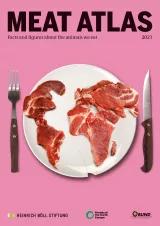
Livestock production and meat consumption stimulate outbreaks of diseases that can be transmitted from wild animals to humans. Such zoonoses can have catastrophic consequences – as Covid-19 has shown.

The International Organization for Animal Health estimates that 60 percent of all infectious diseases in humans are zoonotic: they can be transmitted from animals to humans and vice versa. They cause some 2.5 billion cases of illness in humans each year, from malaria to Covid-19 – and 2.7 million deaths.
One of the best-known zoonotic diseases is rabies. It is still present in many countries. But many other zoonotic diseases have emerged only recently, like bird flu, severe acute respiratory syndrome (SARS), West Nile virus, and “mad cow” disease (bovine spongiform encephalopathy, or BSE). Then, of course, there is Covid-19, which is thought to have originated at a wildlife market in the Chinese city of Wuhan, where the virus is said to have jumped to humans, possibly through the consumption of bushmeat.
The circumstances of meat production and consumption play a central role in the transmission of zoonoses to humans. Research has found that almost 75 percent of the various known zoonoses can be traced to wildlife – from consuming the meat of wild animals, for example. Because more and more land is being used for agricultural production and the habitat of wild animals is being destroyed, the spaces occupied by wild animals and humans increasingly overlap. This increases the risk of people contracting diseases from infected animals. Intermediate hosts such as ticks and mosquitoes also play a role. Unless there is a change in policy, the share of zoonotic diseases in the human disease burden will rise as the human population of the world increases and as consumption patterns shift towards more meat.
An example of the connection between environmental destruction and zoonoses is the well-researched outbreak of Nipah disease in Malaysia. Between August and October 1997, slash-and-burn agriculture and a severe drought in neighbouring Indonesia destroyed about 5 million hectares of forest. Huge plumes of smoke prevented large numbers of flowers and fruits in Malaysia’s forests from flourishing. Flying foxes, carriers of the Nipah virus, therefore sought feed in nearby mango plantations. There, the virus was transmitted – through either their saliva or their urine – to domestic pigs who also fed on the mangoes. The pigs in turn infected farmers, who fell ill from a form of encephalitis. This brain infection caused hundreds of deaths; the mortality rate was around 40 percent.
Increased human presence, a reduction in wildlife habitat and a higher number of domestic animals: these three factors make the transmission of diseases from animals to humans more likely. According to a study published in the scientific journal Nature, the clearing or draining of land for farming, as well as agricultural production, can be linked to over 25 percent of all infectious diseases and more than 50 percent of all zoonotic infectious diseases in humans.
Industrial livestock production also raises the risk of disease transmission. While the world’s human population has doubled in the last 50 years, global meat production has more than tripled. In 2017, the world had some 1.5 billion cows, one billion pigs, almost 23 billion poultry birds and more than 2 billion sheep and goats. Often, many tens of thousands of animals are kept together in confined spaces.
The World Health Organization and the Food and Agriculture Organization of the United Nations have for years warned of the dangers of pandemics in connection with industrial livestock farming, especially regarding poultry and pigs. Intensive forms of management, where the genetic variability of the animals is low, are particularly problematic. If a virus enters such a farm, it can spread easily because it can find many suitable host cells in one fell swoop. Close contact then creates a high risk for humans too.
The trade in live animals and meat products can also spread zoonoses around the world. The Scientific Task Force on Avian Influenza and Wild Birds, which works with the United Nations, is convinced that the viruses that cause avian flu are not only transmitted by wild and migratory birds. It also sees a threat in the international trade in poultry, as well as in infections on poultry farms. The viruses enter the wild from there and are transmitted to wild birds.
How dangerous avian flu is depends on the pathogen on one hand, and on the amount of human contact with diseased or dead birds on the other. Since 2003, around 850 people globally have fallen ill from avian flu caused by the pathogen H5N1. More than half of them, 450 people, have died. But if human-to-human infection were to occur, millions of deaths could result. The spread of Covid-19 has at least shown what has often been ignored: to reduce the risk of future pandemics, the biodiversity of our planet must be protected and industrial livestock production must be transformed.


